Dark Nights’ Targets, Bright Pre-Dawn Planets Bracket a Globular Cluster, and a Moon and Planet Party in the Post-Sunset Sky!
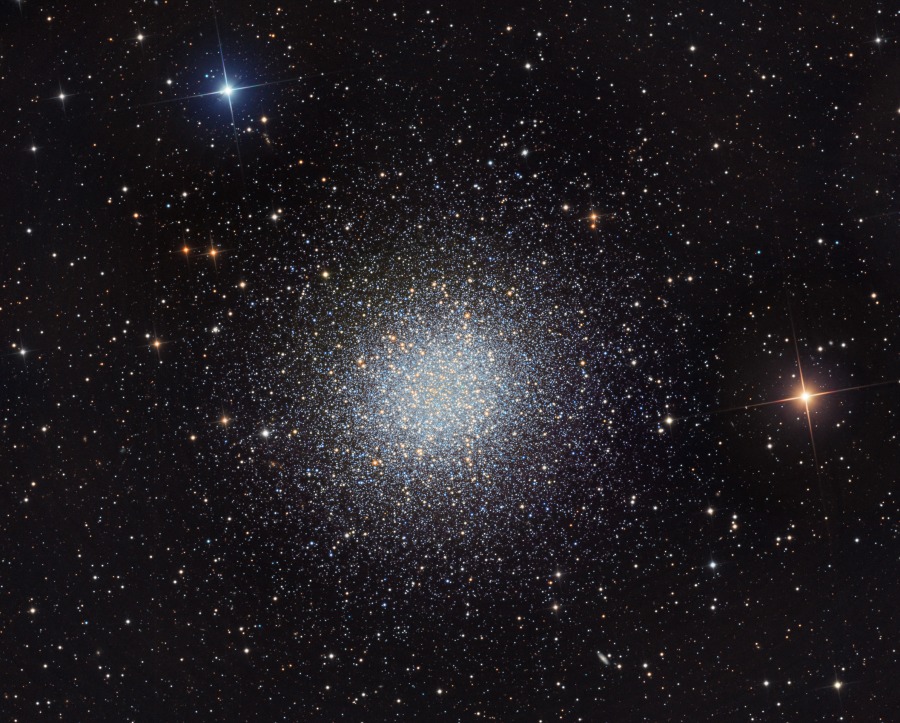
This image of globular star cluster Messier 13 was captured by Martin Pugh of New South Wales, Australia. Left to right, it spans 40 arc-minutes, or 1.3 times the full moon’s diameter. The cluster, which could hold up to million yellow and blue stars, is approximately 23,000 light years away from our solar system. NASA APOD for June 14, 2012.
Hello, Mid-May Stargazers!
Here are your Astronomy Skylights for the week of May 17th, 2020 by Chris Vaughan. Feel free to pass this along to your friends and send me your comments, questions, and suggested topics. You can also follow me on Twitter as @astrogeoguy! Unless otherwise noted, all times are expressed in Eastern Time.
I can bring my Digital Starlab portable inflatable planetarium to your school or other daytime or evening event, or teach a session online. Contact me through AstroGeo.ca, and we’ll tour the Universe or the Earth’s interior together!
Comet SWAN has reportedly started to fizzle – but it’s still bright enough to see with unaided eyes, especially if you live at a southerly latitude. The moon’s position in the pre-dawn sky and then through new moon will deliver dark evening skies for looking at globular clusters, planetary nebulas, and galaxies. Speedy Mercury will pass close to departing, brilliant Venus in the western sky after sunset – and the young crescent moon will join them on the coming weekend. Here are your Skylights!
Bright Comet SWAN Update
As I mentioned last week, a comet named c/2020 F8 (SWAN) has become bright enough to see with unaided eyes. It’s reached about magnitude +5.5! Its orbit is keeping it too low in the sky and too close to the sun for easy viewing by people living at mid-northerly latitudes. But folks at more southerly latitudes, or in the Southern Hemisphere, are getting good views of it.
Unfortunately, the comet has stopped brightening as expected – a sign it may be disintegrating as it feels the heat of the sun. It is still bright enough to see in binoculars and backyard telescopes, though. It should look like a greenish fuzzy patch with a faint narrow tail that extends to the upper right (or celestial north). Comet SWAN is predicted to reach peak brightness around May 27 when it swings around the sun at perihelion.
This week, look for Comet SWAN sitting low in the northwestern sky after dusk – at 9 pm local time. This week its orbit will take it east through Perseus (the Hero), roughly in the direction of the very bright star Capella. From Tuesday to Wednesday, the comet will fly closely past the medium-bright star Algol, which is also known as Beta (β) Persei. On Thursday and Friday, the comet will slide several finger widths to the lower left (or 3.5° to the celestial south) of the star Delta (δ) Persei, which itself is near Perseus’ brightest star, Mirfak.
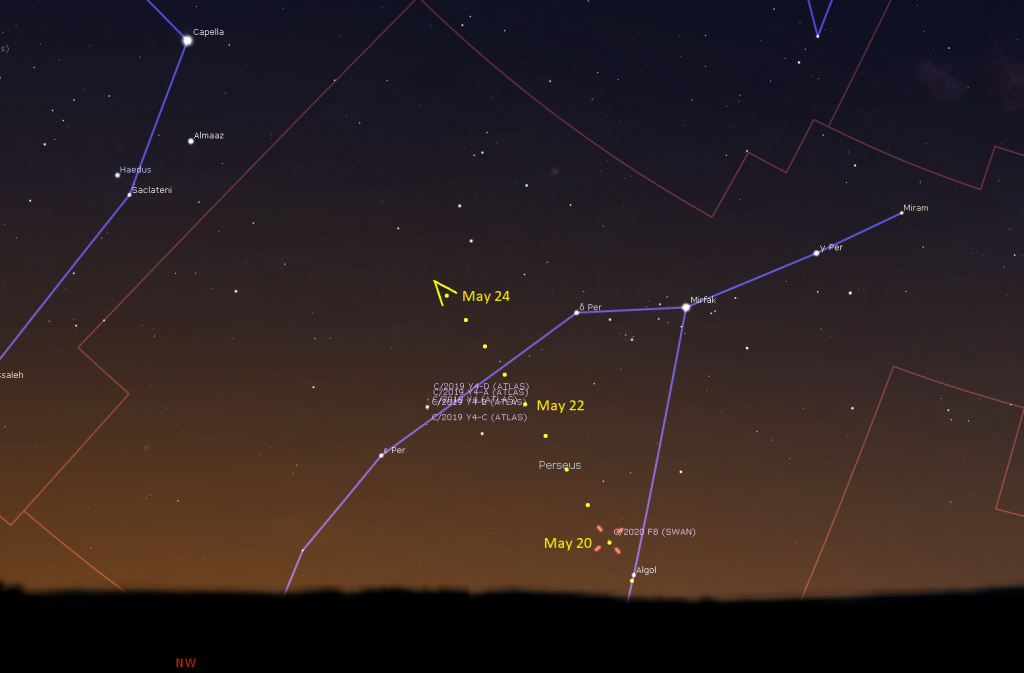
Interestingly, on Thursday and Friday, May 21-22, Comet SWAN will pass a slim palm’s width to the right (or 5° to the celestial west) of the last bright comet that fizzled – Comet c/2019 Y4 (ALTAS). I posted a sky chart here showing SWAN’s path over the month of May. This week’s path is below.
The Moon and Planets
Early risers can see the very old crescent moon sitting low in the eastern sky before sunrise on Monday and Tuesday morning. Then the moon will become hidden beside the sun. At its new moon phase on Friday, May 22 at 1:39 pm Eastern Time (or 17:39 Greenwich Mean Time) the moon will be travelling between the Earth and the sun. Since sunlight is only shining on the side of the moon aimed away from us, and the moon is in the same region of the sky as the sun, the moon will be hidden from view everywhere on Earth until Saturday.
The re-appearance of the young moon after sunset on Saturday will bring to an end the holy month of Ramadan. On Saturday and Sunday, the young moon will join the two inner planets Venus and Mercury in the western sky after sunset – staging a moon-and-planets party that will be well worth heading outside to see!
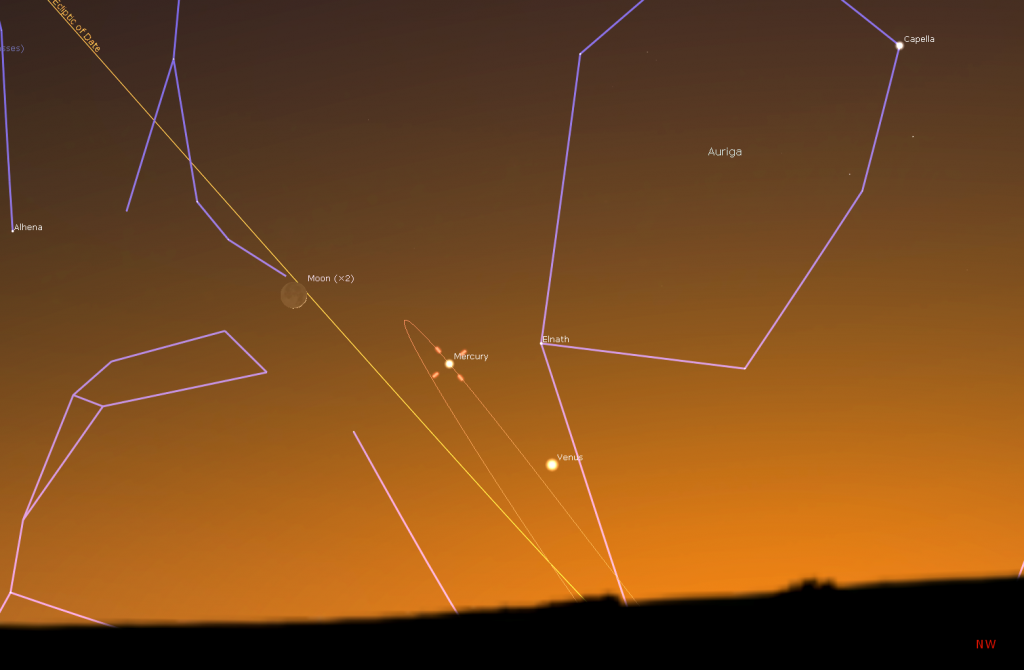
After sunset on Saturday night, May 23, the moon will exhibit an extremely thin crescent, and it will be positioned very low over the west-northwestern horizon. (If you use binoculars to search for it, make sure that the sun has dropped completely below the horizon first.) To help you find the moon, use very bright Venus as your guide. The moon will sit a slim palm’s width to the lower left (or 5° to the celestial southwest) of our sister planet.
Mercury will be there, too. The comparatively faint, but swift planet will be sitting a few finger widths to the upper left (or 3.3° to the celestial east) of Venus. The moon will set at about 9:45 pm local time – followed a short time later by the two planets. On Sunday night, the moon will be much easier to spot. After 24 hours it will have climbed to a position a fist’s diameter to Venus’ upper left, with faint Mercury sitting between them.
You don’t need to wait for the moon to arrive to see Venus and Mercury this week. They’ll be there in the northwestern sky every night after sunset. The two planets will be easily told apart, since Venus will appear nearly 30 times brighter than Mercury. When viewed in a backyard telescope, Mercury will show a nearly fully illuminated disk, while Venus will show a very slim crescent. This difference in illumination is happening because Venus is passing between Earth and the sun while Mercury is on the far side of the sun.
While Venus is descending and decreasing its angular separation from the sun, Mercury is climbing higher and increasing its separation from the sun. Tonight (Sunday), Mercury will sit almost a fist’s diameter below Venus. From Sunday to Thursday, their separation will steadily shrink. On Thursday, Mercury will close to a finger’s width below (or 1° to the celestial southwest of) Venus. On the following evening Mercury will still be close, but a bit higher than Venus.
If you want to easily see the inner planets’ less-than-fully-illuminated disks, aim your telescope at them as soon as you can pick them out of the darkening sky. In a twilit sky, bright Venus’ out-of-round shape will be more apparent. And, when they are higher in the sky you’ll be viewing the planets more clearly – through less of Earth’s distorting atmosphere.
Mercury will be very well positioned for viewing after sunset during the second half of May. After many, many months, however, these are the final weeks for seeing Venus shining in the evening. On June 3 it will pass the sun and then transition into the eastern pre-dawn sky.
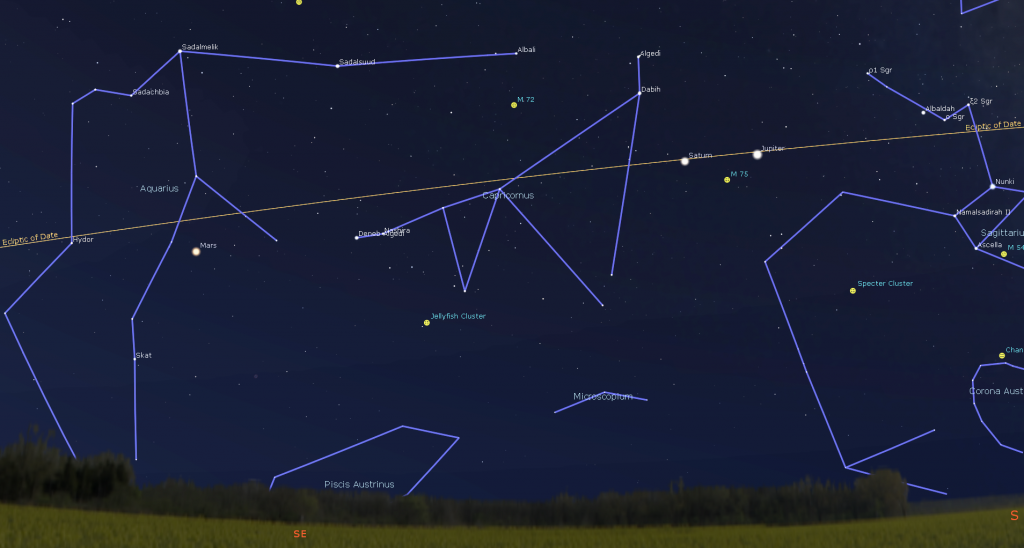
Three bright planets continue to hold court in the southeast before sunrise. Jupiter is the brightest, and first to rise – shortly before 1 am local time. On May 31, Jupiter will finally begin to rise before midnight – signaling the start of 2020’s planet-watching season!
In the Eastern Time zone, Jupiter’s Great Red Spot will be crossing the planet’s disk on Wednesday morning and Friday morning. Jupiter’s moon Ganymede will cast its small, round, black shadow on Jupiter on Thursday morning, May 21 before 1:50 am EDT. Europa’s shadow will cross the planet later that same morning between 2:19 am and 5 am EDT.
Saturn, looking somewhat dimmer and yellowish, will rise at about 1 am local time this week. The Ringed Planet will remain less than a palm’s width to the left (east) of Jupiter all year. For the next two weeks, the globular star cluster designated Messier 75 will be positioned below and between Saturn and Jupiter. Messier 75 shines with a visual magnitude of 9.2. Without a bright moon in the sky, the cluster should be visible in binoculars and backyard telescopes as a small, fuzzy patch positioned approximately 1.5 finger widths below (or 1.5° to the celestial south of) the two bright planets.
Reddish Mars will rise almost two hours after the two gas giant planets. Mars is steadily increasing in disk size and brightness because Earth is travelling towards it. All three planets will remain visible in the lower part of the sky until almost sunrise – with brighter Jupiter hanging on a bit longer than the other two.
Dark Skies Deliver Deep Sky Sights
Except for those who live north of 60° North latitude (The Land of the Midnight Sun) this week will give the world another set of dark, moonless nights. In case you missed it, head over to last week’s Skylights for information on seeing spring galaxies visible again this week. I included sky charts that show where they are.
During late May, the best globular star clusters observable from mid-northern latitudes become well-placed in the eastern evening sky. Globular star clusters, or globulars, are densely packed, spherical concentrations of old stars that orbit our galaxy. Containing hundreds of thousands to millions of stars, they might even be the cores of former galaxies that our Milky Way’s gravity has stripped the gas and dust from.

In early evening, look for 7.7 magnitude Messier 53 (or M53) in Coma Berenices (Berenice’s Hair) and the spectacular magnitude 6.2 Messier 3 (M3) in Canes Venatici (the Hunting Dogs). M53 is located just to the left of the medium-bright star Diadem, and M3 is located a fist’s diameter above the very bright star Arcturus.
As the evening wears on, Messier 5 in Serpens Caput (the Snake’s Head) and Messier 92 in Hercules will be carried higher, making them easier to see. Both of those globulars also shine at an easy magnitude 6.5. For the finale, spend some time enjoying the brightest one – the Great Hercules Cluster, aka Messier 13. All of these objects will reach their highest altitudes and best appearance, in the hours after midnight.

Dark evening skies also allow for hunting down planetary nebulae, the corpses of stars that had a similar mass to our sun. They were too small to end their lives as a black hole or supernova. Planetary nebulae show little disk shapes in telescopes, reminding their discoverers of planets – hence their name. They have absolutely no other connection to planets!
Start in early evening in the western sky with the magnitude 9.68 Eskimo Nebula (NGC 2392) in Gemini (the Twins) and the magnitude 8.6 Ghost of Jupiter Nebula (NGC 3242) in Hydra (the Water-Snake). The late evening eastern sky offers the northerly Cat’s Eye Nebula (NGC 6543) at magnitude 8.1, the Blinking Planetary Nebula (NGC 6826) at magnitude 8.8 in Cygnus (the Swan), and the well-known, magnitude 8.8 Ring Nebula (NGC 6720) in Lyra (the Harp).
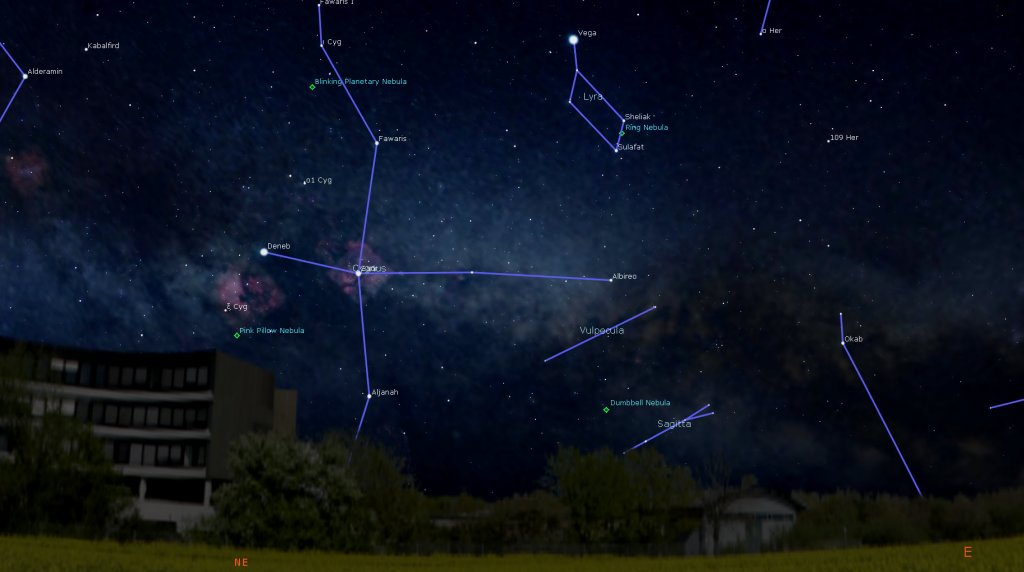
Public Astro-Themed Events
Due to the COVID-19 virus, in-person public star parties and lectures have been cancelled or postponed for the moment. Here are some Internet-based astro-themed activities.
On Thursday, May 21 at 7 pm, RASC National and SkyNews magazine will present their next, free, online broadcast at www.youtube.com/rascanada. This week, RASC archivist Randall Rosenfeld will present Truth at the Eyepiece, discussing the differences between historical astronomical drawings and sketches and our modern telescope views and photographs. Details are here.
Our David Dunlap Observatory Saturday night events may be cancelled, but we’re still pleased to offer the next best thing – a free online talk by Doctoral Candidate Mohamed Shaban. Tune in to the RASC Toronto Centre’s YouTube channel at 7:30 pm EDT on Saturday, May 23 to see his talk Weighing the Universe With a Balloon-Borne Telescope. More information is here.
For the next two weeks, our Insider’s Guide to the Galaxy online sessions will be hosted by Paul Owen, who is returning to talk about taking and processing astrophotos. I’ll be back in June. Details on this and the upcoming sessions are here.
Many astronomers are running broadcasts of the views through cameras attached to their telescopes while they describe the item and take questions. A search for the terms “star party” on YouTube and FaceBook should let you find live or pre-recorded sessions.
The Canadian organization Discover the Universe is offering astronomy broadcasts via their website here, and their YouTube channel here.
On many evenings, the University of Toronto’s Dunlap Institute is delivering live broadcasts. The streams can be watched live, or later on their YouTube channel here.
The Perimeter Institute in Waterloo, Ontario has a library of videos from their past public lectures. Their Lectures on Demand page is here.
Keep looking up, and enjoy the sky when you do. I love questions and requests. Send me some!